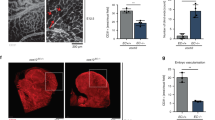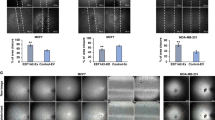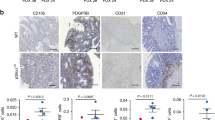Abstract
INEFFICIENT vascular supply and the resultant reduction in tissue oxygen tension often lead to neovascularization in order to satisfy the needs of the tissue1. Examples include the compensatory development of collateral blood vessels in ischaemic tissues that are otherwise quiescent for angiogenesis and angiogenesis associated with the healing of hypoxic wounds2. But the presumptive hypoxia-induced angiogenic factors that mediate this feedback response have not been identified. Here we show that vascular endothelial growth factor (VEGF; also known as vascular permeability factor) probably functions as a hypoxia-inducible angiogenic factor. VEGF messenger RNA levels are dramatically increased within a few hours of exposing different cell cultures to hypoxia and return to background when normal oxygen supply is resumed. In situ analysis of tumour specimens undergoing neovascularization show that the production of VEGF is specifically induced in a subset of glioblastoma cells distinguished by their immediate proximity to necrotic foci (presumably hypoxic regions) and the clustering of capillaries alongside VEGF-producing cells.
This is a preview of subscription content, access via your institution
Access options
Subscribe to this journal
Receive 51 print issues and online access
$199.00 per year
only $3.90 per issue
Buy this article
- Purchase on Springer Link
- Instant access to full article PDF
Prices may be subject to local taxes which are calculated during checkout
Similar content being viewed by others
References
Adair, T. A., Gay, W. J. & Montani, J.-P. Am. J. Physiol. 259, R393–R404 (1990).
Knighton, D. R. et al. Science 221, 1283–1285 (1983).
Folkman, J. Adv. Cancer Res. 43, 175–202 (1985).
Hirano, A. & Matsui, T. Hum. Path. 6, 611–621 (1975).
Jellinger, K. Acta neurochirurgica 42, 5–32 (1978).
Connolly, D. T. et al. J. clin. Invest. 84, 1470–1478 (1989).
Leung, D. W., Cachianes, G., Kuang, W.-J., Goeddel, D. V. & Ferrara, N. Science 246, 1306–1309 (1989).
Gospodarowicz, D., Abraham, J. A. & Schilling, J. Proc. natn. Acad. Sci. U.S.A. 86, 7311–7315 (1989).
Ferrara, N. & Henzel, W. Biochem. biophys. Res. Commun. 161, 851–858 (1989).
Conn, J. et al. Proc. natn. Acad. Sci. U.S.A. 87, 1323–1327 (1990).
Burger, P. C., Vogel, F. S., Green, S. B. & Strike, T. A. Cancer 56, 1106–1111 (1985).
Dvorak, H. F. et al. J. exp. Med. 174, 1275–1278 (1991).
Tischler, E. et al. J. biol. Chem. 266, 11947–11954 (1991).
Ferrara, N., Houck, K. A., Jakeman, L. B., Winer, J. & Leung, D. W. J. cell Biochem. 47, 211–218 (1991).
Jakeman, L. B., Winer, J., Bennett, G. L., Altar, A. & Ferrara, N. J. clin. Invest. 89, 244–253 (1992).
D'Amore, P. A. & Thompson, R. W. A. Rev. Physiol. 49, 453–464 (1987).
Vlodavsky, I. et al. Proc. natn. Acad. Sci. U.S.A. 84, 2292–2296 (1987).
Kourembanas, S., Hannan, R. I. & Faller, D. V. J. clin. Invest. 86, 670–674 (1990).
Rondon, I. J. et al. J. biol. Chem. 266, 16594–16598 (1991).
Knighton, D., Schumerth, S. & Fiegel, V. in Current Communications in Molecular Biology (eds Rifkin, D. B. & Klagsbrun, M.) 150–154 (Cold Spring Harbor Laboratory Press, New York, 1987).
Senger, D. R. et al. Science 219, 983–985 (1983).
Keck, P. J. et al. Science 246, 1309–1312 (1989).
Kinasewitz, G., Groome, L., Marshall, R., Leslie, W. & Diana, H. J. appl. Physiol. 61, 554–560 (1986).
Olsen, S. P. Brain Res. 368, 24–29 (1986).
Motro, B., Itin, A., Sachs, L. & Keshet, E. Proc. natn. Acad. Sci. U.S.A. 87, 3092–3096 (1990).
Bonthron, D. et al. Nucleic Acids Res. 14, 7125–7127 (1986).
Benda, P., Lightbody, J., Sato, G., Levine, L. & Sweet, W. Science 161, 370–371 (1968).
Yaffe, D. & Saxel, O. Differentiation 7, 159–166 (1977).
Chrigwin, J. M. Przbyla, A. E., McDonald, R. T. & Rutter, W. J. Biochemistry 18, 5294–5299 (1979).
Minty, A. J. et al. J. biol. Chem. 256, 1008–1014 (1981).
Author information
Authors and Affiliations
Rights and permissions
About this article
Cite this article
Shweiki, D., Itin, A., Soffer, D. et al. Vascular endothelial growth factor induced by hypoxia may mediate hypoxia-initiated angiogenesis. Nature 359, 843–845 (1992). https://doi.org/10.1038/359843a0
Received:
Accepted:
Issue Date:
DOI: https://doi.org/10.1038/359843a0
This article is cited by
-
Pediatric non-galenic pial arteriovenous fistula’s characteristics and outcomes: a systematic review
Child's Nervous System (2024)
-
Automated segmentation of choroidal neovascularization on optical coherence tomography angiography images of neovascular age-related macular degeneration patients based on deep learning
Journal of Big Data (2023)
-
miR-210-3p enriched extracellular vesicles from hypoxic neuroblastoma cells stimulate migration and invasion of target cells
Cell & Bioscience (2023)
-
Biology and therapeutic targeting of vascular endothelial growth factor A
Nature Reviews Molecular Cell Biology (2023)
-
Expression of hypoxia-inducible genes is suppressed in altered gravity due to impaired nuclear HIF1α accumulation
Scientific Reports (2023)
Comments
By submitting a comment you agree to abide by our Terms and Community Guidelines. If you find something abusive or that does not comply with our terms or guidelines please flag it as inappropriate.



